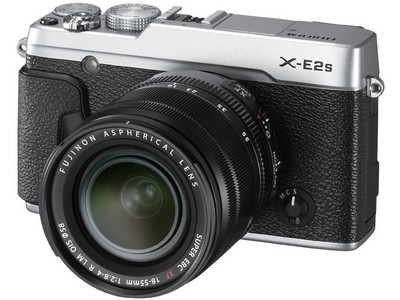

How to choose a compact camera with interchangeable lens
Compact cameras with interchangeable lenses (also known as mirrorless cameras) are constructed without a mirror, which makes them relatively light and small. Nevertheless, they share one of the main advantages of SLR cameras, namely interchangeable lenses. Compact cameras with interchangeable lenses are suitable for demanding beginners and advanced photographers.

Advantages and disadvantages
Frequently asked questions when choosing a compact camera with interchangeable lens
Who are compacts with interchangeable lenses designed for?
Compact cameras with interchangeable lenses are popular among experienced photographers who how to get the most from such devices. Owners of these cameras want the high performance associated with SLRs but in a more compact size. They enjoy experimenting and want to take a wide range of high-quality images with plenty of room for creativity.
How do compacts with interchangeable lenses differ from other types of digital camera?
As the name suggests, compacts with interchangeable lenses have most in common with compact cameras. However, they feature better optics and sensors and richer options (such as full control over exposure), while still retaining a relatively small size and weight. Like digital SLRs, one big advantage is the ability to use interchangeable lenses.
Why should I choose a compact camera with interchangeable lens?
If you want to take better photos of holidays, trips or family celebrations, but you are still more interested in the final image than the actual photographic process, then this type of camera is suitable for you. Furthermore, the ability to use interchangeable lenses will give you far more options than with a normal compact digital camera.
What's important when choosing a compact camera with interchangeable lens?


Zoom
Allows you to zoom in and out of your subject. There are typically two types of zoom: optical and digital. Optical zoom uses the movement of the objective lens to actually change the focal length, so the image quality remains the same; digital zoom simply enlarges and recrops a part of the image, causing a loss of image quality. For compact cameras with interchangeable lenses and SLRs, the optimal zoom depends on the type of lens.

Focal distance
The focal length of a lens indicates its angle of view and can be divided into two categories: fixed focus lenses and zoom lenses.
Lens types:
Fish Eye (8-14 mm) - for widescreen pictures. Images feature the characteristic hemispherical distortion.
Super wide-angle (15-24) - suitable for landscape photography, interiors and architecture.
Widescreen (25-34 mm) - suitable for interior and landscape photographs as well as photo reportage.
The perspective of the human eye (50 mm) - corresponds to the viewing angle of the human eye. Suitable for reportage and portrait photography.
Medium lenses (35-100 mm) - perspective close to that of the human eye. Used especially in everyday situations and portrait photography.
Telephoto (100-300 mm) - suitable for portrait, reportage, landscape and sports photography.
Super telephoto (over 300 mm) - used for shooting wildlife and sports photography.

Aperture
Aperture refers to the opening of a lens's diaphragm, through which light passes. The bigger the aperture, the more light the lens is able to let through, which in turn effects the exposure time. Aperture also plays a crucial part in determining the depth of field, or the range of distance in an image that appears sharp. Aperture is measured in so-called f-numbers or f-stops.
- F / 1.8 and below is suitable for portrait lenses, for which a shallow depth of field is important. Such low apertures are possible with some fixed lenses.
- An aperture of about f / 2.8 is achievable with a better lens with varying focal lengths. It can be used in photojournalism and sports photography.
- High f-numbers (eg. F / 16) are used in landscape and architecture photography.

Stabilisation
Some lenses feature optical image stabilisation, which can minimise blur caused by camera shake. Stabilisation is especially important for reportage and portrait photography.

Focus
Fast and accurate focussing is required when shooting fast motion scenes, typically in sport. The focus mechanism is powered either by a standard motor housed within the body of a digital SLR, or an internal ultrasonic motor, which is both faster and quieter.

SLR kits with lenses
Compact cameras with interchangeable lenses can be purchased individually or in a set with one or two lenses.
Glossary - compact cameras with interchangeable lenses
Lens
The lens is an essential part of any digital camera. While photographing objects, the lens focusses light onto a sensor and allows the adjustment of the focal length to zoom in or out of the onject.
Macro mode
Macro mode allows you to photograph objects at the minimum focussing distance. The result is a image that enlarges the object to a scale of 1:1 to 30:1. Macro mode is mostly used to photograph insects and flowers.
- SLRs can take macro photos using a special macro lens or other accessories.
- Compacts can use auto macro modes to focus on close objects, but the magnification ratio is usually below 1:1
Optical zoom
Zoom is the ability of the lens to make distant objects look closer. This is made possible by adjusting the objective lens and changing the focal length. Unlike digital zoom, optical zoom does not result in a loss of image quality.
Sufficient optical zoom
- 3× for compact cameras
- 10× for ultrazoom cameras
- For digital SLRs, depending on the lens



Chip size
Sensor size influences the depth of field and quality of the captured image. The larger the chip, the less noise in the final photograph. The two main types of sensor are CCD and CMOS.